Looking for a rifle cartridge that delivers heavy hitting performance at long range to hunt with this fall? Here’s what you need to know about the 6.8 Western.
Browning and Winchester raised a few eyebrows when they announced the 6.8 Western to the world in early 2021. Many people were understandably very skeptical of what the new cartridge offered to hunters that they couldn’t get with a more established cartridge. The fact that they released the 6.8 Western in the middle of a global pandemic and a historically bad ammo shortage didn’t help with perceptions either.
I admit I was very skeptical at first as well and did not think a new caliber was really needed at the time. However, I eventually decided to take a look at the 6.8 Western with an open mind and I was pleasantly surprised by what I discovered.
In this article, I’m going to discuss the history as well as the strengths and weaknesses of the 6.8 Western in detail. I’ll also provide some information on how the 6.8 Western compares to the 6.5 PRC and .270 Winchester cartridges to give you an idea of what sort of performance you can expect from the cartridge and so you can decide if it best fits your needs as a hunter.
6.8 Western History
The story of the 6.8 Western really begins with the .270 Winchester.
Formally released by Winchester all the way back in 1925, the .270 Winchester offered hunters blazing fast velocities and extremely flat trajectories compared to other cartridges in use at the time.
Designed by necking down a .30-06 case to use .277″ instead of .308″ bullets, the original .270 Winchester load shot a 130 grain bullet at approximately 3,140 feet per second (2,846 ft-lbs of energy). Originally released with the Winchester Model 54 rifle, the cartridge developed a well-deserved reputation for effectiveness on thin-skinned game over the years.
The cartridge understandably developed a large and devoted following during the course of the 20th Century and the .270 caliber became irrevocably linked to the Winchester brand. Well, Winchester decided to follow-up on their long running success with a new .270 caliber cartridge at the beginning of the 21st Century.
Winchester released the 270 Winchester Short Magnum (270 WSM) in 2002. That cartridge also fired a 277-caliber bullet, but used a shorter and fatter case. This gave the 270 WSM two advantages over the 270 Winchester: it had a significantly larger case capacity that could hold more powder and it would fit in a short action rifle instead of the longer standard or long action rifles the .270 Winchester is used in.
Indeed, the 270 WSM had an approximately 200-300fps velocity advantage over the .270 Winchester. This resulted in a slightly flatter trajectory, more resistance to wind drift, and more retained energy at all ranges.
However, while the 270 WSM was fairly commercially successful for Winchester, many felt like the cartridge didn’t live up to its full potential. Looking back on things, the 270 WSM suffered from the same limitations as the other short action magnum cartridges designed around that time, like the 7mm Remington Short Action Ultra Magnum (7mm SAUM) and 7mm Winchester Short Magnum (7mm WSM), in that it used a design focused solely on higher velocity instead of heavier and more aerodynamic bullets.
Specifically, the 270 WSM used the same 1:10″ rifling twist rate as the original .270 Winchester. This twist rate worked extremely well for the bullets in the 130gr-150gr weight range most popular for the two cartridges.
While those bullets are outstanding for many hunting applications, they don’t quite offer the sort of the extended performance more and more hunters and shooters are looking for these days. Shooters and hunters have started to place a much higher emphasis on long, heavy, and aerodynamic projectiles in recent years with the rise in popularity of long range shooting.
In response, the various ammunition manufacturers have worked to satisfy that demand with offerings using sleek, low drag bullets. The Nosler AccuBond and AccuBond Long Range, the Barnes LRX, the Hornady ELD-X, and the various Berger bullets are all great examples of extremely aerodynamic hunting projectiles that have really taken off in recent years, especially in 6.5mm, 7mm, and .30 caliber.
Unfortunately, those slower rifling twist rates used by the .270 Winchester and 270 WSM held back development of those long, heavy, low-drag bullets in .277″ caliber.
For instance, there are several different hunting bullet options available in 6.5mm, 7mm, and .30 caliber with a G1 ballistic coefficient over .600 like the 143gr ELD-X in 6.5mm (.625 BC), the 168gr VLD Hunting in 7mm (.618 BC), and the 210gr AccuBond Long Range in .30 caliber (.661 BC). Comparable bullets in .277″ caliber include the 145gr ELD-X (.536), 150gr VLD Hunting (.518 BC), and the 150gr AccuBond Long Range (.591 BC).
Yes, hunters using custom rifles with fast enough rifling twist rates can use some of the very heavy and extremely aerodynamic 277″ caliber bullets that are available these days like the 170gr Berger Extreme Outer Limits (EOL) with a .662 BC. Those heavy bullets simply weren’t an option for hunters who don’t handload and who use factory production rifles though.
That changed when Nosler rolled out their new 27 Nosler cartridge in 2020.
Designed from the beginning to use the new .277″ caliber 165gr AccuBond Long Range (.620 BC), 27 Nosler rifles used a faster 1:8.5″ rifling twist rate and took the performance of the .277″ caliber to the next level by allowing for the use of extremely high BC bullets in a .277″ caliber cartridge.
The Nosler cartridges are excellent performers that fire bullets with higher ballistic coefficients at very fast velocities, but they’re still fairly niche offerings and are primarily available in custom rifle builds (with a handful of exceptions). Even so, this development set things in motion for the next domino to fall.
That domino fell on 15 January 2021 when Browning and Winchester jointly announced the release of the new 6.8 Western cartridge. Also known as the 6.8 Winchester Western, the announcement of the new round took some by surprise.
Instead of just revamping an older cartridge to use heavier bullets, designers at Winchester and Browning decided from the very beginning to build a purpose built cartridge that will handily outperform the old .270 Winchester and 270 WSM.
Here’s what Winchester’s lead engineer for the 6.8 Western, Kyle Masinelli, had to say:
We wanted to get into the untapped potential of bullets above the .264 caliber. We only wanted bullets with G1 BCs above .600 and our goal was to beat the .300 Winchester Magnum’s 180-grain AccuBond’s energy delivery at 500 yards.
To that end, they borrowed a page out of the playbook used in other successful cartridge releases like the 6.5 PRC. Similar in appearance to the 270 WSM and 6.5 PRC, the 6.8 Western has an overall length of 2.955″ and uses a beltless case that’s 2.02″ long, .535″ in diameter at the base, and has a 35 degree shoulder.
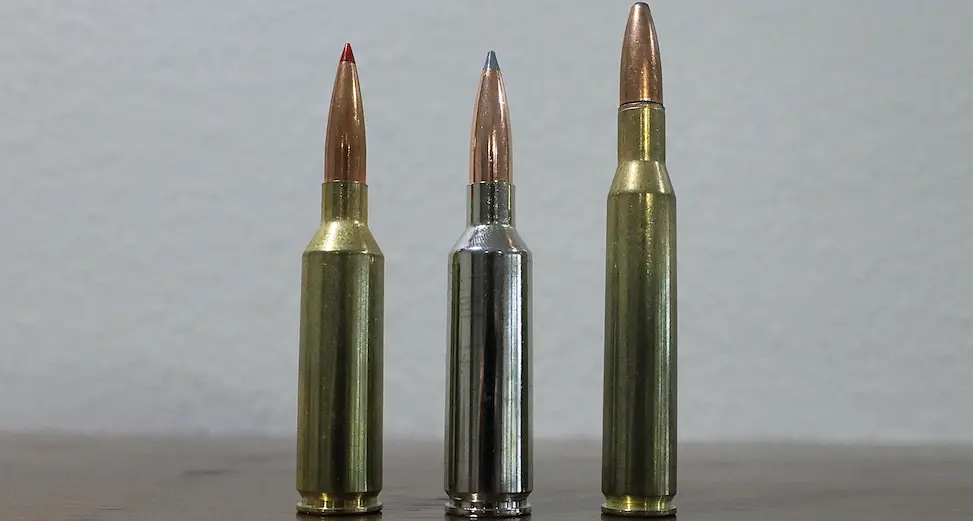
Though the 270 WSM cartridge has an overall length of 2.86″ and fits neatly into the traditional definition of a short action cartridge, the 6.8 Western exceeds those standards by a hair with a maximum cartridge overall length (COAL) of 2.955″. Even so, the 6.8 Western will feed reliably from short action AICS-pattern box magazines that are so common with modern rifles.
In addition to lengthening the COAL of the 6.8 Western, designers at Winchester moved the cartridge shoulder back slightly and decreased the case length compared to the 270 WSM. Similar to what designers at Hornady did with the 300 PRC, this resulted in a little bit more space for the bullet outside the case (also known as head height).
This facilitated the use of long, heavy-for-caliber bullets without requiring them to be seated too deeply into the case that they intrude into the powder column.
Those longer bullets also required a faster rifling twist for proper stabilization in flight. So, they designed the 6.8 Western for use in rifles with a 1:7.5″ or 1:8″ rifling twist rate (1:8″ is SAAMI standard).
The end result is a short and handy .277 caliber cartridge that delivers impressive ballistics that compare very favorably to some noted long range-cartridges.
6.8 Western Ballistics
Typical 6.8 Western ballistics are a 165gr bullet at 2,970 fps (3,226 ft-lbs) or a 175gr bullet at 2,835 fps (3,124 ft-lbs) with a 24″ barrel. Those loads use very aerodynamic bullets that retain lots of kinetic energy and deliver excellent extended range performance on deer and elk-sized game.
As a point of comparison, the 165-175gr bullets used by the 6.8 Western are heavier than the 140-147gr bullets common with the 6.5 Creedmoor and 6.5 PRC, heavier than the 130-150gr bullets most common with the 270 Winchester and 270 WSM, and comparable to the heaviest 160-175gr bullets used by the 7mm Remington Magnum.
However, assuming similar bullet ogive profiles, the 6.8 Western bullets are a little more aerodynamic, have a higher sectional density (SD), and can be fired at a higher velocity than those used by the 7mm Remington Magnum in typical factory loads.
Sectional density (SD) is a measure of the ratio of the diameter of a projectile to its mass. All other things equal, a heavier projectile of a given caliber will be longer and therefore have a higher sectional density and consequently penetrate deeper than projectiles with a lower mass and sectional density.
For instance, Nosler offers a 7mm Remington Magnum load firing a 168gr AccuBond Long Range with a .616 BC, a sectional density of .298, and a muzzle velocity of 2,880fps. Winchester has an almost identical load for the 7mm Rem Mag firing the same 168gr AccuBond Long Range at 2,900fps. Compare those loads to Winchester’s 6.8 Western offering firing a 165-grain Nosler AccuBond Long Range with a .620 BC, a sectional density of .307, and a muzzle velocity of 2,970fps.
That works out to 2″ more bullet drop, .5″ more wind deflection, and 71 fewer ft-lbs (~4%) of energy remaining at 500 yards for the 7mm Rem Mag. That’s a very small edge to be sure, but it’s an advantage for the 6.8 Western over the 7mm Rem Mag nonetheless.
Finally, the cartridge accomplished Kyle Masinelli’s stated goal of delivering more energy at 500 yards than Nosler’s 300 Win Mag 180gr AccuBond loads with 1,862 ft-lbs of energy compared to 1,745 ft-lbs with the .300 Winchester Magnum. The 6.8 Western also a slight edge in terms of trajectory (the .300 Win Mag has 2″ more bullet drop and about 3.5″ more wind deflection at 500 yards) and about 10% less free recoil energy than the .300 Win Mag.
6.5 PRC vs 6.8 Western vs 270 Win
First, the 6.5 PRC uses .264″ bullets while the 6.8 Western and .270 Winchester use .277″ bullets.
Additionally, they all use different weight bullets.
While the 6.5 PRC can use lighter 120gr, 127gr, and 130gr bullets, it’s most commonly used with 140gr, 143gr, or 147gr bullets. The .270 Winchester most often uses bullets in the 110-150 grain range, with 130 grain bullet and 150 grain bullets being the most common.
Finally, the 6.8 Western can use the same lighter weight 130-grain and 150-grain bullets as the .270 Winchester (and fire them quite a bit faster), but it’s optimized for 165 grain, 170 grain, and 175 grain bullets.
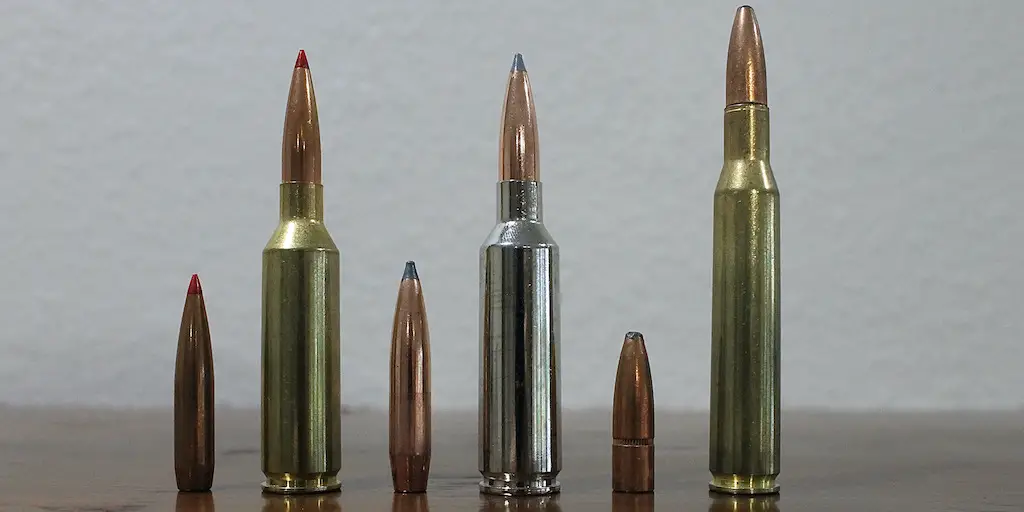
The .270 Winchester has the longest maximum overall length (3.34″) and longest case length (2.54″). The 6.8 Western and 6.5 PRC have the same maximum overall lengths of 2.955″ and case lengths of 2.02″ and 2.03″ respectively.
This makes sense as the .270 Winchester is designed for use in standard or long actions rifles (same as the 30-06) while the 6.5 PRC and 6.8 Western are considered short action cartridges.
The .270 Winchester has a .473″ rim diameter while the 6.5 PRC and 6.8 Western have larger .532″ and .535″ rim diameters. Interestingly, the 6.8 Western has the largest case capacity of the three while the 6.5 PRC and .270 Winchester have very similar case capacities even though they use a dramatically different case design.
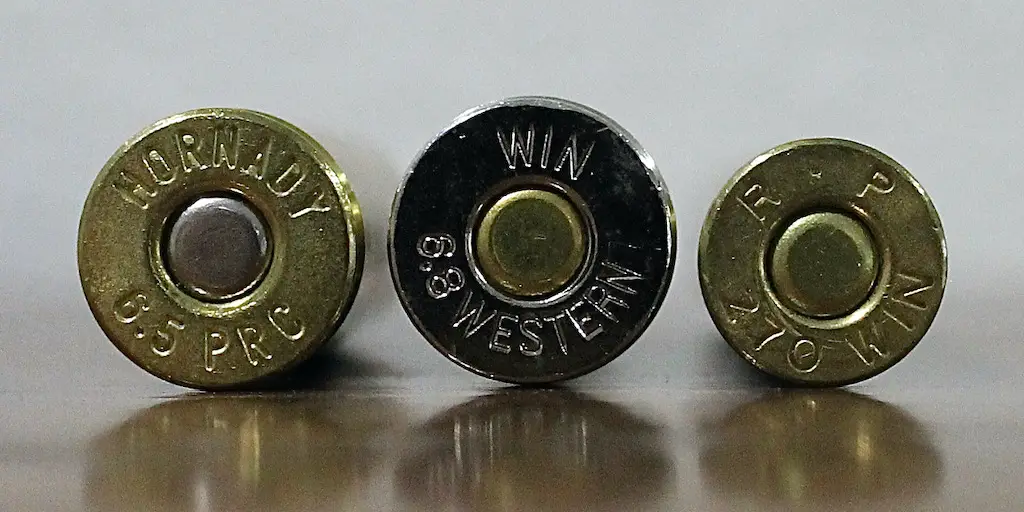
Finally, the 6.5 PRC, 6.8 Western, and .270 Winchester all have the same SAAMI maximum pressure of 65,000psi.
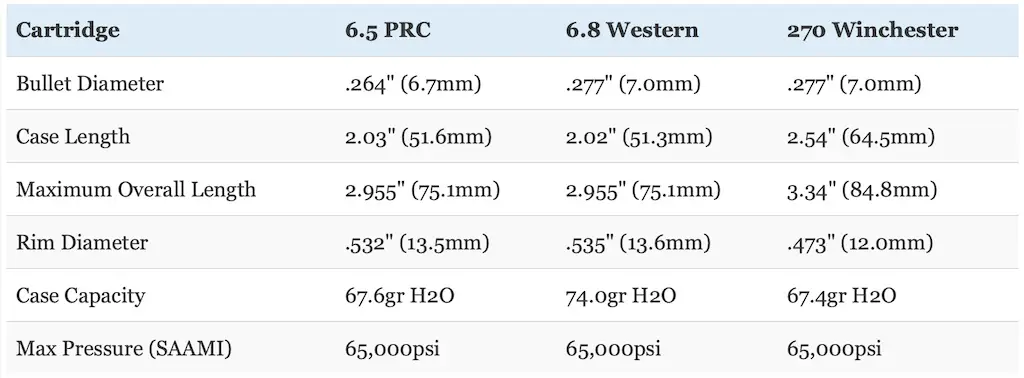
Those differences in the external dimensions of the 6.5 PRC, 6.8 Western, and .270 Winchester translate into some interesting differences in their ballistic performance.
The table below compares Winchester Expedition Big Game Long Range and Browning Long Range Pro Hunter factory ammo in 6.5 PRC loaded with 142gr AccuBond Long Range (.625 BC) and 130gr Sierra Tipped GameChanger (.510 BC) bullets, in 6.8 Western loaded with 165gr AccuBond Long Range (.620 BC) and 175gr Sierra Tipped GameChanger (.617 BC), and in .270 Winchester loaded with 150gr AccuBond Long Range (.591 BC) and 140gr Sierra Tipped GameChanger (.508 BC) bullets.
Note: the Sierra Tipped GameChanger is sometimes referred to as the Sierra Tipped GameKing bullet or the Sierra TGK.
All six loads used a 200 yard zero.
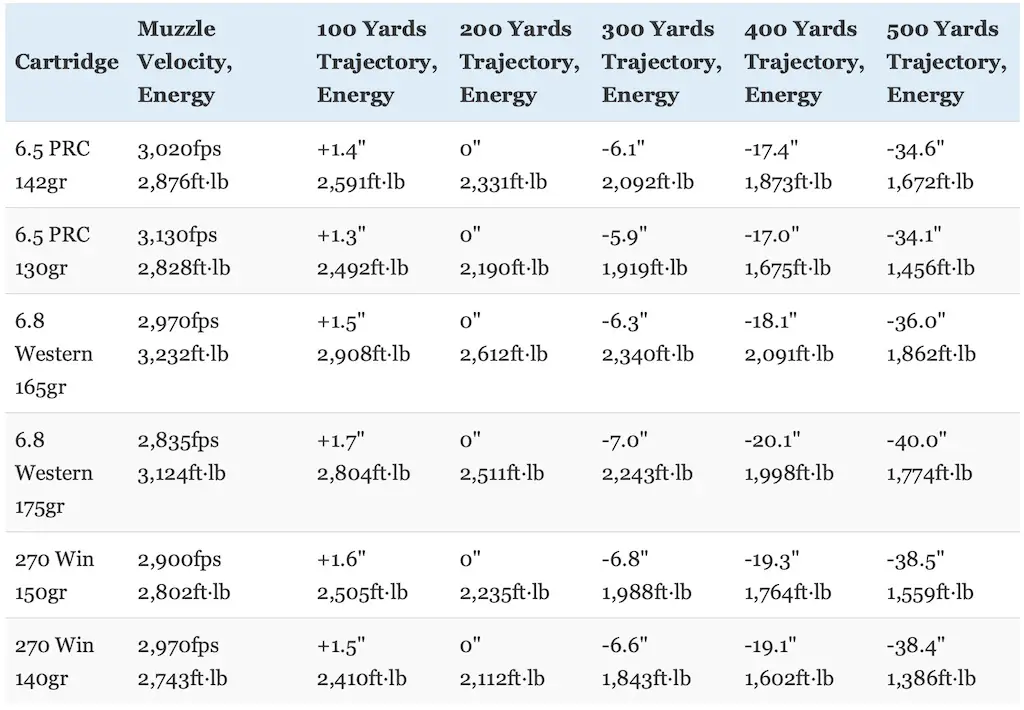
With about 2-6″ less bullet drop than the 6.8 Western and about 4.5″ less bullet drop than the .270 Winchester at 500 yards, the 6.5 PRC has the flattest trajectory of the bunch. The 6.8 Western has about 2.5″ less bullet drop at 500 yards than the .270 Winchester with the Nosler bullet, but actually has about 1.5″ more drop with the Sierra bullet.
However, the 6.8 Western has an edge over the other two in terms of kinetic energy at all ranges.
The Nosler bullet used by the 6.5 PRC has a slightly higher BC than the Nosler bullet used by the 6.8 Western, but the situation is reversed with the Sierra bullets. So the ~12% advantage the 6.8 Western has with kinetic energy at the muzzle drops a tiny bit to ~11% at 500 yards with the Nosler bullet, but a ~10% advantage in muzzle energy turns into an ~22% advantage in kinetic energy with the Sierra bullet.
Both bullets used by the 6.8 Western are more aerodynamic than the bullets used by the .270 Winchester, especially the Sierra bullet. So, the 6.8 Western has an ~15% advantage in muzzle energy and an ~19% advantage in kinetic energy over the .270 Winchester at 500 yards with the Nosler bullet and an ~14% advantage in muzzle energy turns into an ~28% advantage in kinetic energy at 500 yards.
The chart below compares how much a 10 mile per hour crosswind impacts those same 6.5 PRC, 6.8 Western, and .270 Winchester loads out to 500 yards.
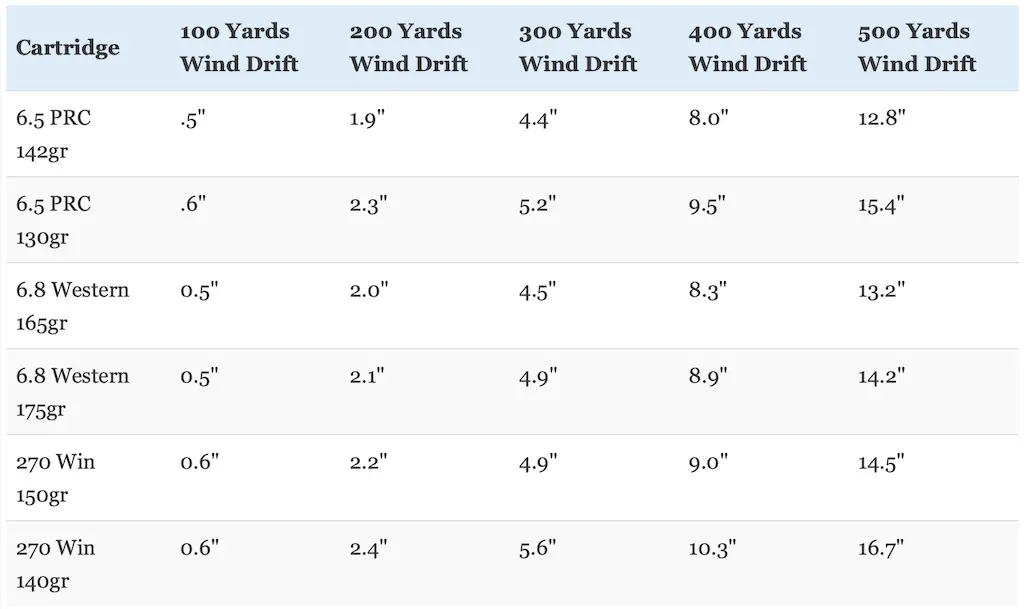
The same general trends hold true with regards to wind deflection as well.
The 6.5 PRC ABLR has the least wind deflection, followed by both 6.8 Western loads, the .270 Winchester ABLR, the 6.5 PRC Sierra, and finally the .270 Winchester Sierra. Just .4″ separates the 6.5 PRC and 6.8 Western Nosler loads and 1.3″ separates the 6.8 Western and .270 Winchester Nosler loads.
Once again, the 6.5 PRC and 6.8 Western are extremely similar, with a slight edge going to the 6.5 PRC. Likewise, the 6.8 Western has a slightly larger (though still not gigantic) advantage over the .270 Winchester out to 500 yards.
Now let’s talk about recoil.
The table below compares the recoil produced by handloads that are very similar to the AccuBond Long Range loads compared above for the 6.5 PRC, 6.8 Western, and .270 Winchester when fired from identical rifles.
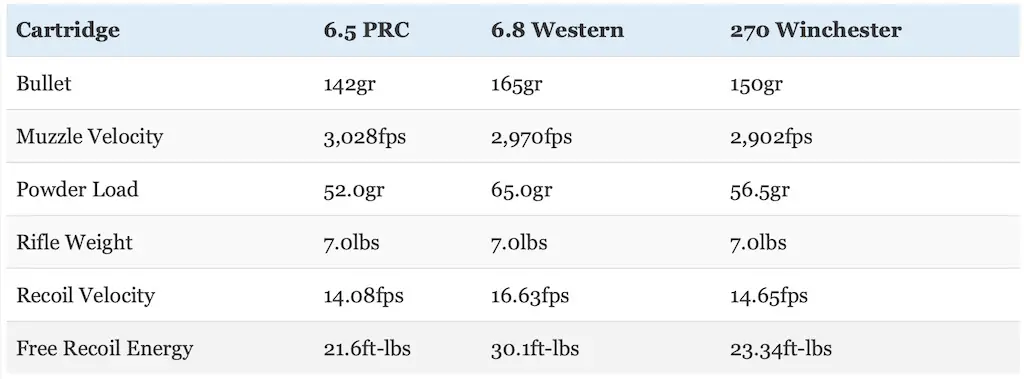
Felt recoil will vary from shooter to shooter and rifle to rifle, but free recoil energy is still a useful way to compare cartridges.
Interestingly, the 6.5 PRC and .270 Winchester have very similar amounts of free recoil energy, but the 6.8 Western has quite a bit more than both of them. Specifically, we’re looking at about 28-39% more recoil for the 6.8 Western.
While we’re not talking about ridiculous amounts of recoil here, 6.8 Western recoil has been described as “stout” or “noticeable” depending on the exact person in question. For reference, it does have a bit less recoil than typical .300 Win Mag loads and recoil very similar to (maybe a little more depending on the exact load) the 7mm Rem Mag.
This is the sort of recoil that many people can handle without a lot of trouble, especially when shooting a rifle that fits them well, that has a good recoil pad, or is equipped with a muzzle brake or suppressor. Even so, it’s still worth mentioning that the 6.8 Western does kick a lot more than either the 6.5 PRC or the .270 Winchester.
Don’t underestimate the impact that recoil has on the ability of a person to shoot accurately either. Some people do handle recoil better than others, but all other things being equal, they will absolutely shoot more accurately with a milder recoiling cartridge.
Additionally, there are a couple of other factors that are also worth discussing.
First, the 6.8 Western and .270 Winchester larger diameter bullets than the 6.5 PRC.
Specifically, the larger diameter .277″ bullets used by the 6.8 Western have about 10% more frontal surface area (also known as cross sectional area) than the 6.5 PRC (.0603 vs .0547 square inches). All other things being equal, a bigger bullet will make a bigger hole, cause more tissue damage, and result in more blood loss.
This is a definite, though not gigantic advantage in favor of the 6.8 Western.
Those new, heavy, and extremely aerodynamic .277″ caliber bullets used by the 6.8 Western also have a relatively high sectional density (SD).
Sectional density (SD) is a measure of the ratio of the diameter of a projectile to its mass. All other things equal, a heavier projectile of a given caliber will be longer and therefore have a higher sectional density and consequently penetrate deeper than projectiles with a lower mass and sectional density.
120 grain, 129 grain, 140 grain, and 143 grain .264″ bullets have sectional densities of .246, .264, .287, and .293.
130 grain, 150 grain, 165 grain, 170 grain, and 175 grain .277″ bullets have sectional densities of .242, .279, .307, .317, and .326 respectively.
As a point of comparison, 150 grain, 160 grain, and 175 grain .284″ bullets used by 7mm cartridges (like the .280 AI and 7mm Rem Mag) have sectional densities of .248, .266, .283, and .310 respectively.
There’s a little overlap there, but with the exception of the 175gr 7mm bullets compared to the 165gr .277″ bullets, those 165-175gr .277″ bullets the 6.8 Western is optimized for have a definite edge in sectional density over the heaviest 6.5mm and even 7mm bullets.
Especially when combined with the fact that the 6.8 Western carries more kinetic energy downrange than the 6.5 PRC, those heavier and larger diameter bullets with a higher sectional density are certainly helpful when hunting big game.
What about 6.5 PRC vs 6.8 Western vs 270 accuracy?
While external ballistics are extremely important, performance on paper doesn’t mean a darn thing if you can’t hit your target.
Well, Winchester implemented some design principles with the 6.8 Western to help optimize accuracy. Specifically, they built the cartridge with a tight freebore diameter.
Freebore is the smooth portion of a rifle barrel closest to the cartridge. Having a more snug freebore diameter means there’s less room for the bullet to yaw upon firing before engaging the rifling. This can also help enhance accuracy, especially with extremely long bullets.
So, the designers at Winchester built the 6.8 Western with a tight freebore diameter in a manner similar to what other designers did with the 6.5 Creedmoor and 6.5 PRC. Those cartridges each have just .0001″ clearance around bullets when they’re chambered.
Compare that to .0003″ with a .270 Winchester and .0016″ with the .30-06 Springfield.
In any case, the details will vary on the exact rifle, ammunition, and shooter in question. However, the 6.8 Western certainly has excellent potential for accuracy right up there with the 6.5 PRC.
6.5 PRC vs 6.8 Western vs 270 Win Availability
Finally, let’s talk about availability of rifles and ammunition.
Winchester raised a few eyebrows when they released the 6.8 Western in the middle of a nationwide (and worldwide) shortage of ammunition and firearms. More than a few hunters and shooters reacted to the announcement with anger and frustration that Winchester and Browning were both devoting resources to producing 6.8 Western rifles and ammo at the expense of other more popular cartridges that were in short supply.
I admit that I felt that way initially as well. My opinion has changed a bit since January of 2021 though.
Since it’s such a new cartridge, there is very little competition for 6.8 Western ammo and rifles right now. Indeed, the 6.8 Western is the only centerfire rifle cartridge I’ve personally had uninterrupted access to both rifles and ammunition for during the entirety of 2021.
My situation is not unique and I’m actually aware of several cases of hunters purchasing rifles chambered in 6.8 Western specifically because they could get ammo for it.
Availability likely varies from places to place and I have no doubt that there are areas where you can buy 6.8 Western ammo but not rifles and vice versa. Even so, it’s still one of the more readily available centerfire rifle cartridges in the United States at this time.
That does make more sense now that I think about it though.
I have no idea how much ammo Winchester and Browning have produced for the 6.8 Western in 2021. For the sake of argument though, let’s assume they made 50,000 rounds of amm0 (just a wild guess).
Unlike more widely adopted cartridges, the vast majority of that ammo is likely being purchased by people who actively intend to practice with and actually hunt with that ammo in the near future. The fact that the 6.8 Western is a more specialized cartridge also means it’s not something a casual or brand new hunter is likely to purchase either, which reduces demand for it somewhat.
This is in contrast to a lot of other cartridges where people are buying more than normal to have on hand “just in case.” The newer gun owners and hunters are also much more likely to be purchasing cartridges like the 6.5 Creedmoor, 308, 30-06, etc.
I’m just guessing here, but it appears that Browning and Winchester probably satisfied the 6.8 Western ammo needs of a larger number of hunters to this point with those 50,000 rounds of ammo than they would have by focusing that same production capacity on 270 Winchester or 30-06 ammo.
There’s no guarantee what the future may hold, but at least in the near term, the 6.8 Western seems to have benefited from the ammo shortage. At least as of mid-September 2021, the 6.8 Western is still one of the most widely available centerfire rifle cartridges in the United States.
Compared to the 6.5 PRC and .270 Winchester, it’s not even close: the 6.8 Western is a clear winner in terms of ammo availability at this instant.
So where do we stand overall with these cartridges?
6.8 Western vs 6.5 PRC
The 6.8 Western fires larger and heavier bullets at a slightly lower velocity than the 6.5 PRC. The 6.5 PRC has a slight edge in recoil, trajectory, and wind drift, but the 6.8 Western more kinetic energy at typical hunting ranges and is better for hunting bigger game.
Both cartridges have extremely similar trajectories and similar amounts of wind drift. In fact, both are excellent performers in that category overall when compared to commonly used centerfire hunting cartridges for those who want to squeeze all the performance they can out of a cartridge. The 6.8 Western does have more recoil though.
However, the 6.8 Western combines the flat trajectory and great resistance to wind drift of the 6.5 PRC with heavier and larger diameter bullets that have noticeably more kinetic energy at typical hunting ranges. That might not matter too much when hunting deer or pronghorn, but I’d definitely lean towards the 6.8 Western over the 6.5 PRC for game like bear, elk, or moose.
6.8 Western vs 270 Winchester
The 6.8 Western fires heavier and more aerodynamic 165-175gr bullets at velocities comparable to the 270 Winchester with lighter 130-150gr bullets. Therefore, the 6.8 Western has more recoil, but an edge with trajectory, wind drift, and kinetic energy. It’s also better on bigger game and at longer range.
The 6.8 Western has a definite ballistic advantage over the .270 Winchester in terms of external ballistics. The fact that it can use heavier and more aerodynamic bullets really catapults the 6.8 Western into the next level for work at extended range and/or for hunting bigger game like elk and moose.
That does come at the expense of more recoil though. If we’re being honest, not every hunter will need the extra capability the 6.8 Western provides compared to the .270 Winchester. However, it does provide some great capabilities for those who want or need that extra performance.
6.8 Western Ammo
There is a surprisingly good selection of factory loaded 6.8 Western ammunition these days. At this time, Browning and Winchester are the primary sources of factory 6.8 ammo, but it’s one of the easiest to find centerfire rifle cartridges in the United States as of late 2021.
Most of this ammunition is geared specifically for hunters who want to take advantage of the long range performance of the cartridge. This selection will likely continue to improve if the cartridge takes off with the general hunting public in the next few years.
Specifically, the Browning Long Range Pro Hunter line loaded with 175gr Sierra GameChanger bullets, the Winchester Expedition Big Game Long Range line loaded with 165gr Nosler AccuBond Long Range bullets, the Winchester Ballistic SilverTip line loaded with 170gr Ballistic SilverTip bullets, Winchester Extreme Point Copper Impact line loaded with 162gr Copper Impact bullets, and Winchester Super X line loaded with 170gr Power Point Bullets are the only loaded ammo options I’m aware of for the cartridge.
The ammunition selection for the cartridge is decent online right now and the 6.8 Western isn’t nearly as difficult to find as some other cartridges during the ongoing 2020-2023 ammo shortage.
Best 6.8 Western Ammo For Hunting
Browning and Winchester both make factory 6.8 Western hunting ammo and both brands are available online from time to time. That could very well change in the future, but Winchester Ammunition in particular has done a very good job of continuing to get their ammunition for the cartridge to market in the ongoing ammunition shortage.
If you’d like to learn more about some of the various hunting ammunition choices for the 6.8 Western read this article:
Best 6.8 Western Ammo For Hunting Elk, Deer, & Bear
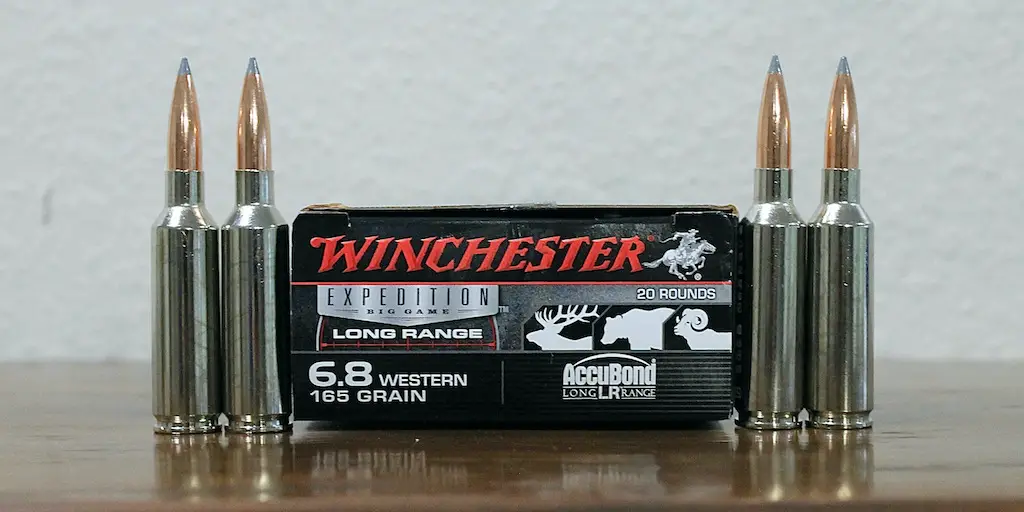
6.8 Western Rifles
Browning and Winchester both rolled out the 6.8 Western in a number of different rifle models from the start. At this instant, 6.8 Western rifles include 7 different versions of the Browning X-Bolt, 14 versions of the Winchester XPR, and 9 version of the Winchester Model 70 bolt action rifles.
In particular, the Browning X-Bolt Western Hunter and the Browning X-Bolt Max Long Range are both fantastic factory rifles for those who want outstanding long range capability in a hunting rifle.
The Max Long Range comes with a 26″ barrel and the Western Hunter uses a 24″ barrel. These rifles are definitely on the long side, but they have lots of reach and those long barrels help maximize the performance of the cartridge at extended range.
I’d personally lean towards the Western Hunter for a 6.8 Western rifle with plenty of reach that isn’t too big or bulky. On the other hand, the Max Long Range is idea for those who prioritize long range capability above all else.
Learn more about all of those 6.8 Western hunting rifle choices (and others) here:
BEST 6.8 WESTERN HUNTING RIFLES
Final Thoughts On The 6.8 Western
It’s clear that the designers at Browning and Winchester put some serious energy into building a superb rifle cartridge with the 6.8 Western. The advantages offered by the 6.8 Western over the old .270 Winchester are more incremental than transformative, but the new cartridge does provide a noticeable benefit to hunters.
This is especially true for those hunting out west for bigger game like elk where distances can start to get pretty long. This rifle cartridge was designed specifically for hunters (as opposed to competition shooters) and delivers in the areas most important to that group of people.
Specifically, the cartridge is extremely flexible and offers an outstanding balance of a flat trajectory, great resistance to wind drift, and heavy hitting performance at long range without excessive recoil, muzzle blast, throat erosion, or extremely short barrel life. Oh and it does that while still fitting in a short action rifle.
I’m not endorsing using the 6.8 Western for extremely long-range shooting situation on a game animal at ridiculous range. However, I am saying I think it ranks up there with other great cartridges for hunting situations in open country like the 7mm Rem Mag and 300 Win Mag.
That said, the 6.8 Western is a very specialized cartridge that probably doesn’t offer serious advantages to the average eastern whitetail hunter. If you never shoot beyond 200 yards, then there’s no need for you to purchase a 6.8 Western unless you just want to.
However, a hunter looking for a good all-around cartridge for use on game ranging from deer and pronghorn up to elk at moose out west could absolutely make use of the advantages offered by the 6.8 Western though. The fact that the 6.8 Western is one of the more widely available centerfire rifle cartridges in the United States during the ongoing ammo shortage is also an advantage in favor of the cartridge.
There’s no guarantee what the future may hold, but if I were in the market for a new hunting rifle and wanted something with outstanding all-around capability that I could actually purchase a good rifle and ammo for right now, then I’d be very seriously considering getting a rifle in 6.8 Western.
It’s not a world changing cartridge or something with magical capabilities, but I think the 6.8 Western is an excellent cartridge that largely performs as advertised. If it sounds like an appealing choice for you, then get a good quality rifle, learn to shoot it accurately, and I’m sure you’ll be happy with how it performs for you afield.
Enjoy this article about the 6.8 Western? Please share it with your friends on Facebook and Twitter.
Browning and Winchester provided information for the history of 6.8 Western. The data used to compare the trajectory and recoil of the cartridges was obtained from Winchester. Maximum pressure and data to compare cartridge sizes for the 6.5 PRC, 6.8 Western, and .270 Winchester were obtained from SAAMI (p28, p85), here, and here). Case capacity information for the 6.5 PRC, 6.8 Western, and .270 Winchester was obtained from Chuck Hawks, The American Rifleman, and Rifle Shooter Magazine. Frontal surface area information was obtained from Chuck Hawks. I used Shooters Calculator to compare trajectories, wind drift, and recoil for the cartridges.
Make sure you follow The Big Game Hunting Blog on Facebook, Instagram, Twitter, and YouTube.
NEXT: BEST 6.5 CREEDMOOR AMMO FOR HUNTING ELK, DEER, AND OTHER BIG GAME
NEXT: 11 BEST HUNTING EAR PROTECTION OPTIONS FOR HUNTERS IN 2021
NEXT: 101 BEST GIFTS FOR HUNTERS
John McAdams is a proficient blogger, experienced shooter, and long time hunter who has pursued big game in 8 different countries on 3 separate continents. John graduated from the United States Military Academy at West Point and is a veteran of combat tours with the US Army in Iraq & Afghanistan. In addition to founding and writing for The Big Game Hunting Blog, John has written for outdoor publications like Bear Hunting Magazine, The Texas State Rifle Association newsletter, Texas Wildlife Magazine, & Wide Open Spaces. Learn more about John here, read some of John’s most popular articles, and be sure to subscribe to his show: the Big Game Hunting Podcast.


It would be interesting to see this comparison across these 3, as well as including the 6.5mm Creedmoor and .270 WSM, to show how much more energy the 6.8 has over the Creedmoor, even though the shooter is sacrificing trajectory and recoil, and how the .270 WSM actually measures up due to those ‘shortcomings’ mentioned early in the article. The data already exists on this website, and I will do my own looking, but other readers might not think to qualitatively compare the 6.8 to the other cartridges in the way that you compare them on this sight. Great article!
Thank you for the in depth and what seems genuine guide for considering the 6.8 W. I have been planning a trip to Montana for mule deer and the itch for something new was pretty strong. I had narrowed my decision to a Nosler 26, .264 win mag, .280 AI, or the 6.8 W. I found a Browning X-bolt Pro Carbon in 6.8 and it is now mine…along with ammo. Finding any of the others for under $2,000 before adding anything – scope/mounts/sling didn’t happen. I’m extremely excited to take this to the range with the new 3-15 Vortex Razor HD LHT. Ok, maybe I’m slightly overgunned for mule deer – but I like bigger bullets.